Vanuatu is known for its diverse and unique bird population. Located in the stunning South Pacific, Vanuatu is home to a variety of endemic and migratory species.
These birds provide a great opportunity to observe and appreciate the beauty of nature in all its forms. From the rare, endemic species of the Pacific to migrating species from North America and Australia, Vanuatu’s avian population is something to behold.
Through careful conservation efforts, Vanuatu’s birds continue to thrive in the wild and provide an amazing experience for visitors.
1. Vanuatu Kingfisher
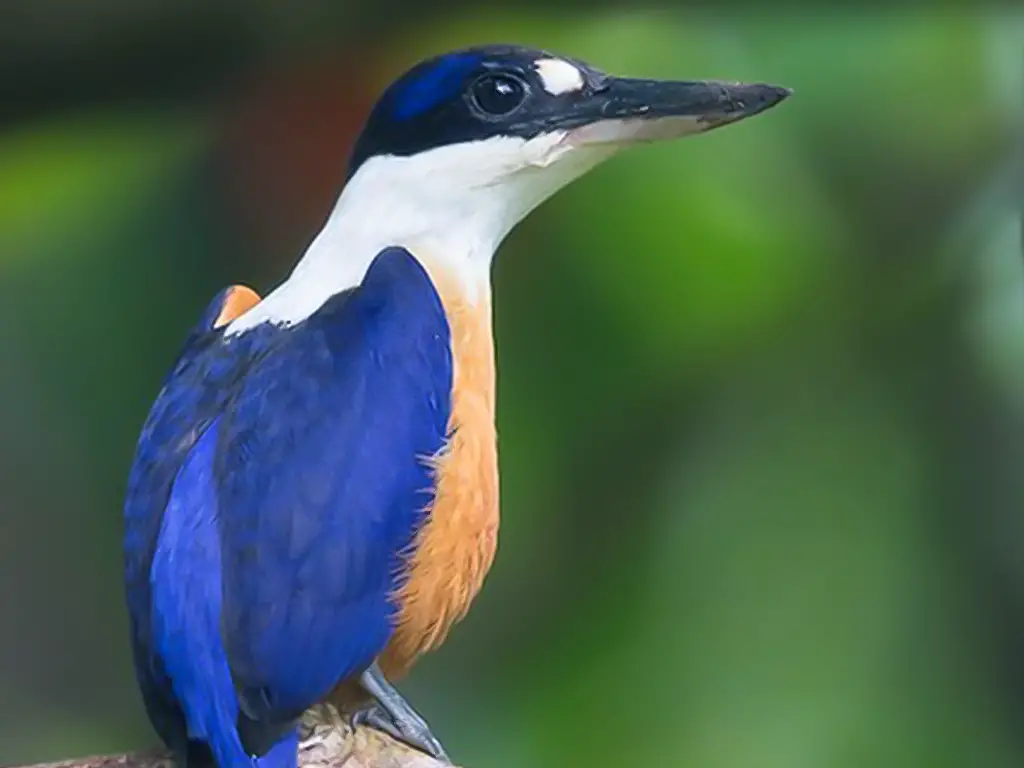
The Vanuatu kingfisher, also known as the chestnut-bellied kingfisher, is an awe-inspiring bird found only on three of the islands in Vanuatu. It has a unique coloration with dark blue feathers above and bright orange underparts.
A white spot rests just before its eyes while a broad black band runs along both sides of its head. The throat and collar are white giving it a striking look that can’t be missed when spotted in nature.
This medium sized species grows up to 19 – 21 cm long making them quite large for their type.
They feed mainly on insects but will sometimes take small vertebrates like lizards or frogs too.
These birds play an important role in keeping insect populations balanced and healthy which helps protect crops from pest damage throughout the region they inhabit helping local farmers out significantly.
Scientific classification:
| Kingdom | Animalia |
| Phylum | Chordata |
| Class | Aves |
| Order | Coraciiformes |
| Family | Alcedinidae |
| Subfamily | Halcyoninae |
| Genus | Todiramphus |
| Species | T. farquhari |
2. Cardinal Myzomela
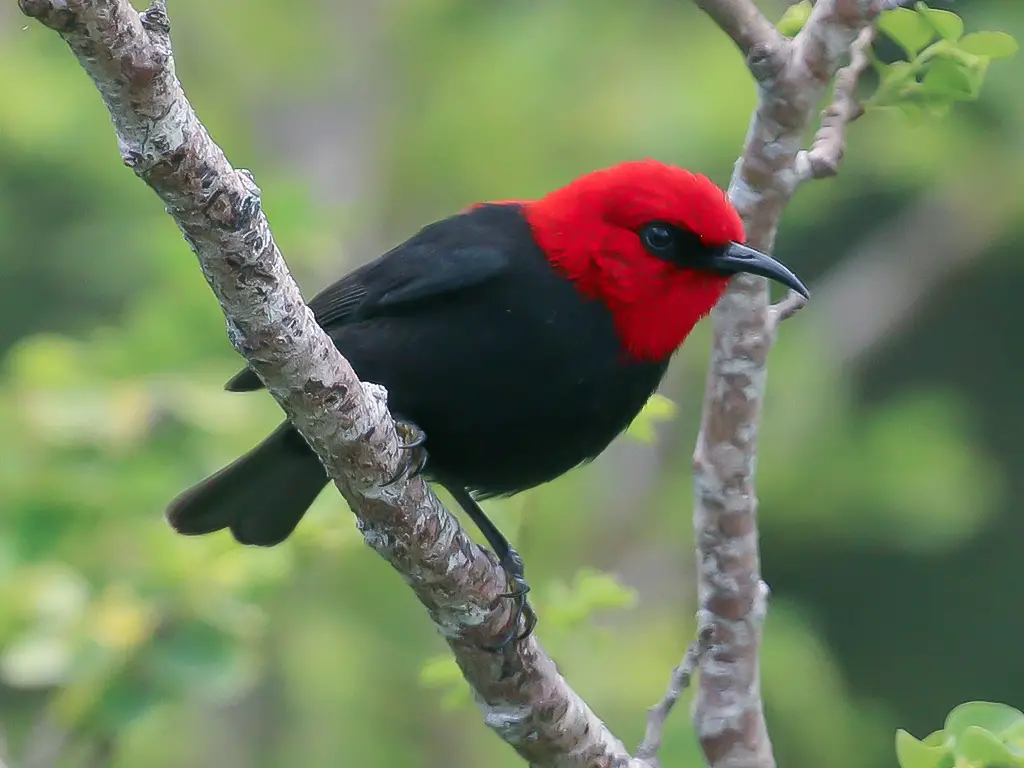
The Cardinal myzomela is a stunning species of bird found in American Samoa, New Caledonia, Samoa, Solomon Islands and Vanuatu.
The male has beautiful scarlet plumage which gave it its name.
It inhabits subtropical or tropical moist lowland forests and mangrove forests. This adaptable species also lives on some Micronesian islands such as Yap.
Its diet consists of nectar from flowers and insects that are caught while foraging among the branches of trees in these habitats.
A shy but energetic bird, the cardinal myzomela often forms flocks with other birds to look for food before returning to roost at nightfall.
Scientific classification:
| Kingdom | Animalia |
| Phylum | Chordata |
| Class | Aves |
| Order | Passeriformes |
| Family | Meliphagidae |
| Genus | Myzomela |
| Species | M. cardinalis |
3. Southern Shrikebill
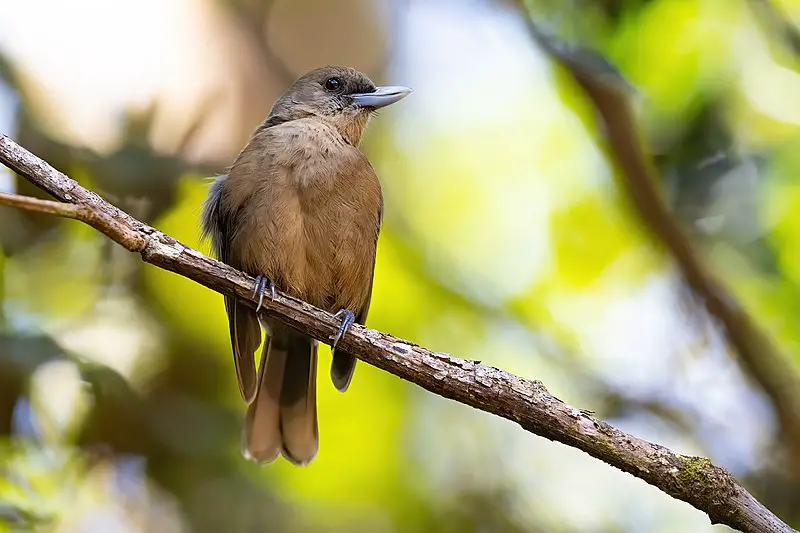
The Southern shrikebill, also known as the brown flycatcher, is a member of the family Monarchidae found in New Caledonia and Vanuatu. It typically inhabits subtropical or tropical moist lowland forests.
This species has two recognized subspecies: C. pachycephaloides pachycephaloidis which can be found in New Caledonia and C. pahycephaloides michalowskii which is native to Vanuatu islands.
The Southern shrikebill usually weighs between 20-28g with an average length of 13 cm from head to tail tip.
Its plumage features greyish above mixed with rufous on face, throat underparts along with yellow tinged wings and upper backside marked by black barring patternings that distinguishes it from other species within its family group.
This species forages mainly on insects but occasionally feeds on fruit too.
They are mostly solitary birds but sometimes join small groups when migrating towards their wintering grounds.
Scientific classification:
| Kingdom | Animalia |
| Phylum | Chordata |
| Class | Aves |
| Order | Passeriformes |
| Family | Monarchidae |
| Genus | Clytorhynchus |
| Species | C. pachycephaloides |
4. Vanuatu White-Eye

The Vanuatu white-eye is a small passerine bird endemic to the beautiful island of Vanuatu. It has bright yellow or yellow-green underparts, and its upper body is mostly greenish in colour.
The adult male can be identified by its distinct yellow forehead. Measuring 11–12 cm (4.3–4.7 in) long, it’s one of the smaller birds found on the island.
Despite this, it remains incredibly common throughout much of Vanuatu – making up an important part of local wildlife there.
Scientific classification:
| Kingdom | Animalia |
| Phylum | Chordata |
| Class | Aves |
| Order | Passeriformes |
| Family | Zosteropidae |
| Genus | Zosterops |
| Species | Z. flavifrons |
5. Vanuatu Megapode
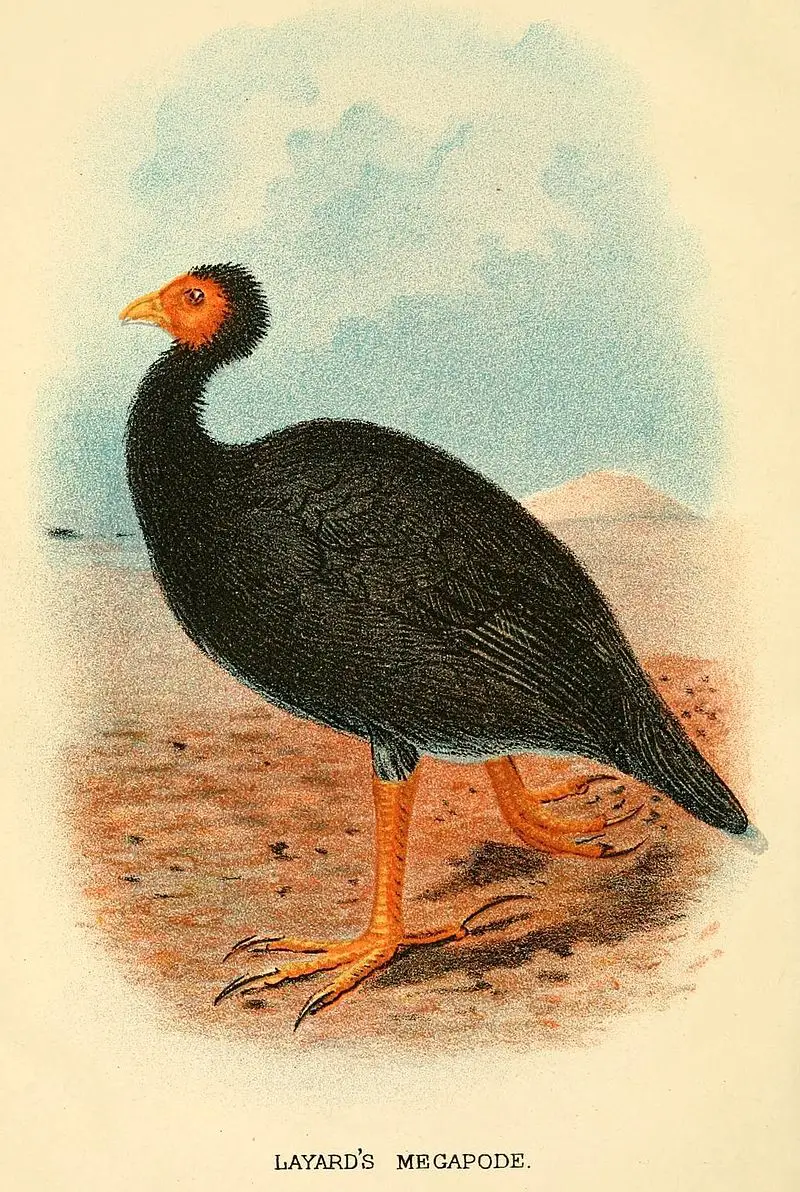
The Vanuatu Megapode is a species of bird belonging to the family Megapodiidae. It can only be found on the island nation of Vanuatu, where it inhabits subtropical or tropical moist lowland forests.
Unfortunately, this beautiful bird is facing threats from habitat loss and egg collecting which have resulted in its population numbers decreasing rapidly over time.
The first specimens for the species were collected by English clergyman Henry Baker Tristram in 1879 and described as Megapodius layardi Tristram.
These birds are characterised by their red facial skin with yellow wattles, grey wings and tail feathers, dark brown plumage along their heads and backs as well as bright yellow feet.
Scientific classification:
| Kingdom | Animalia |
| Phylum | Chordata |
| Class | Aves |
| Order | Galliformes |
| Family | Megapodiidae |
| Genus | Megapodius |
| Species | M. layardi |
6. Mountain Starling
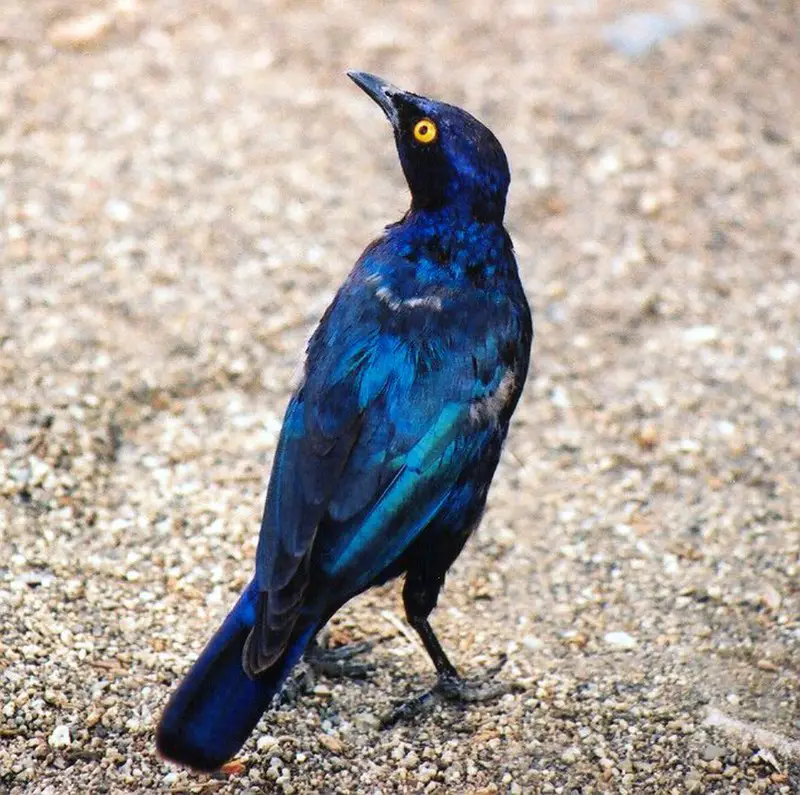
The Mountain starling is a species of bird found exclusively in Vanuatu. It lives mainly in the cloud forest on the island of Espiritu Santo, although it was thought to be extinct until 1991 when an expedition managed to find some individuals.
The bird has black feathers with white spots and bright yellow eyes, giving it quite a striking appearance. Its diet consists mostly of insects and fruits that can be found in its habitat.
Unfortunately due to deforestation this beautiful creature may soon no longer exist – making conservation efforts even more important for its survival into future generations.
Scientific classification:
| Kingdom | Animalia |
| Phylum | Chordata |
| Class | Aves |
| Order | Passeriformes |
| Family | Sturnidae |
| Genus | Aplonis |
| Species | A. santovestris |
7. Pacific Robin
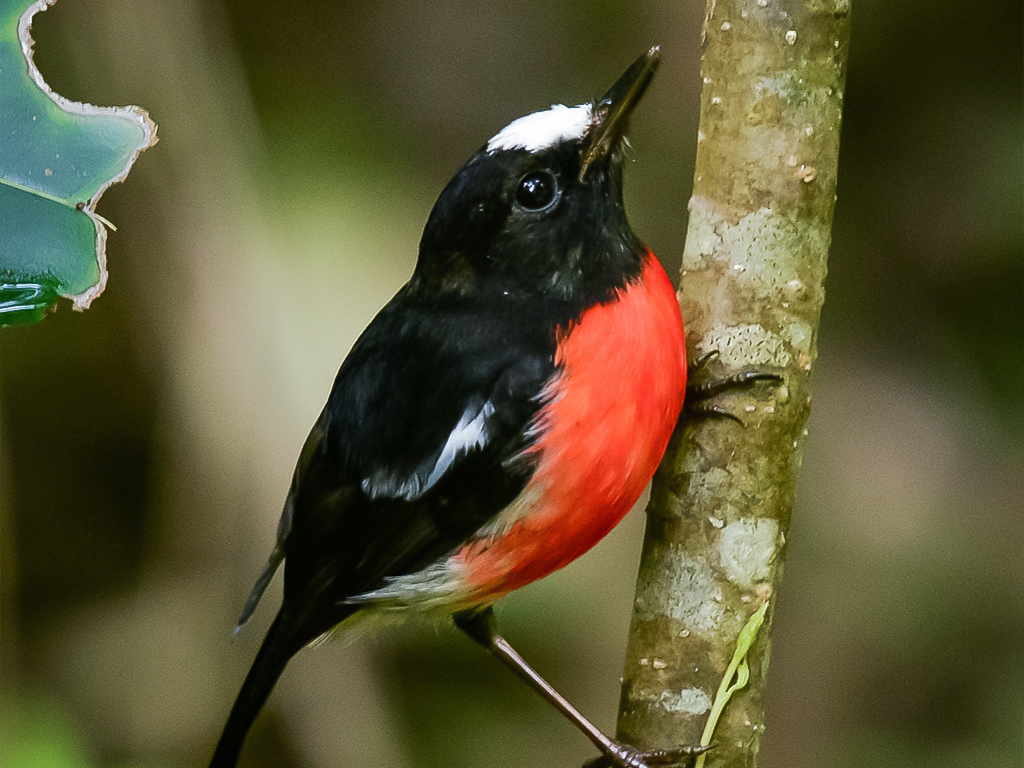
The Pacific robin, a member of the passerine bird genus Petroica, is found in Melanesia and Polynesia. It has distinctive red-breasted plumage similar to that of the scarlet robin found in Australia.
In 1999, taxonomists Schodde and Mason recognised distinctions between these two species leading them to be classified into different genera.
There are currently 13 subspecies of Pacific Robin which display varying colour differences from one another ranging from dull browns through bright oranges and yellows.
The diet mainly consists of insects supplemented by fruit foraging during non breeding seasons as well as occasional visits to garden feeders with suet or mealworms being popular treats on offer.
Scientific classification:
| Kingdom | Animalia |
| Phylum | Chordata |
| Class | Aves |
| Order | Passeriformes |
| Family | Petroicidae |
| Genus | Petroica |
| Species | P. pusilla |
8. Fan-Tailed Gerygone
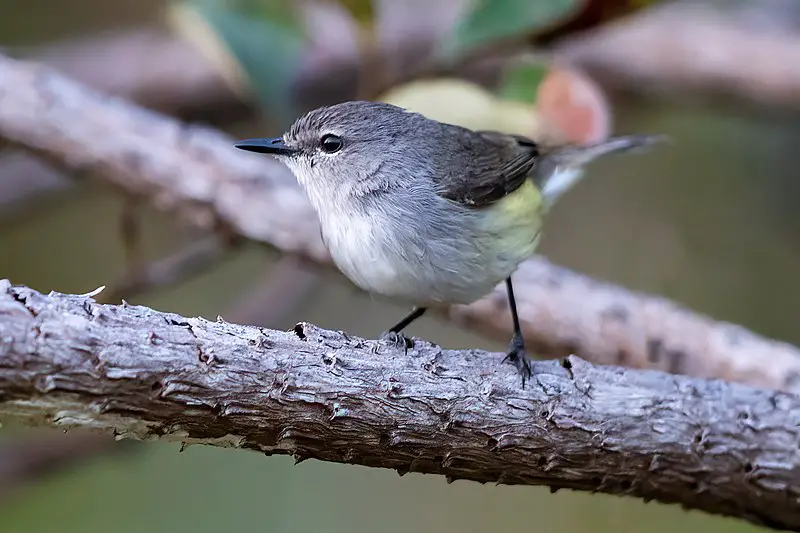
The fan-tailed gerygone is a species of bird belonging to the family Acanthizidae. It resides in New Caledonia and Vanuatu, although its close relative, the Rennell gerygone (G.
citrina) was recently discovered living on the Solomon Islands too. Fan-tailed gerygones have greyish brown uppersides with light yellow undersides, buffy streaks along their sides and white spots on their wings.
Their tail feathers are fanned out at an angle which helps it fly swiftly through dense foliage when foraging or avoiding predators such as cats or rats that may be present in those areas. These birds mostly feed on insects but will also consume fruits occasionally.
They build circular nests from twigs and dry leaves placed low down among grasses where they lay up to three eggs per clutch; both parents take turns incubating them until hatching occurs after around two weeks.
Scientific classification:
| Kingdom | Animalia |
| Phylum | Chordata |
| Class | Aves |
| Order | Passeriformes |
| Family | Acanthizidae |
| Genus | Gerygone |
| Species | G. flavolateralis |
Also Featured In: Birds of New Caledonia,
9. White-Breasted Woodswallow
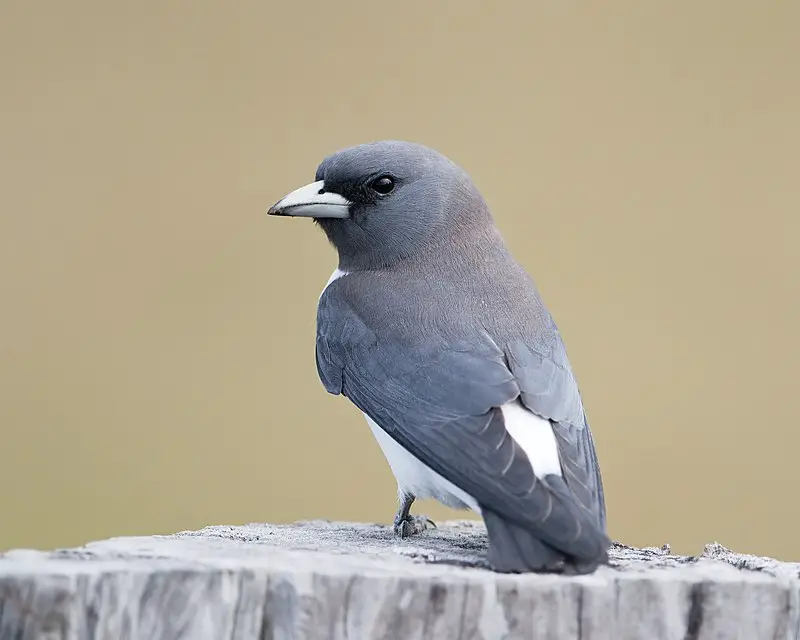
The White-breasted Woodswallow is a medium-sized passerine bird found in the Andaman Islands, Indonesia and Northern Australia.
Its name may be misleading as it does not belong to the family of true swallows but rather belongs to Artamidae which also includes butcherbirds, currawongs and Australian magpie.
These birds are mainly greyish brown with white belly patch and long wings having two pale bars on them.
They feed on insects like ants, beetles etc., captured from foliage or air during flight.
Breeding season for this species starts from October till December when they build their cup shaped nests out of twigs near tree trunks or branches usually high up in trees for protection against predators such as snakes or raptors.
Male woodswallows can often been seen singing loudly while displaying its aerial maneuvering capabilities trying to attract potential mates.
Scientific classification:
| Kingdom | Animalia |
| Phylum | Chordata |
| Class | Aves |
| Order | Passeriformes |
| Family | Artamidae |
| Genus | Artamus |
| Species | A. leucorynchus |
10. Tanna Fruit Dove
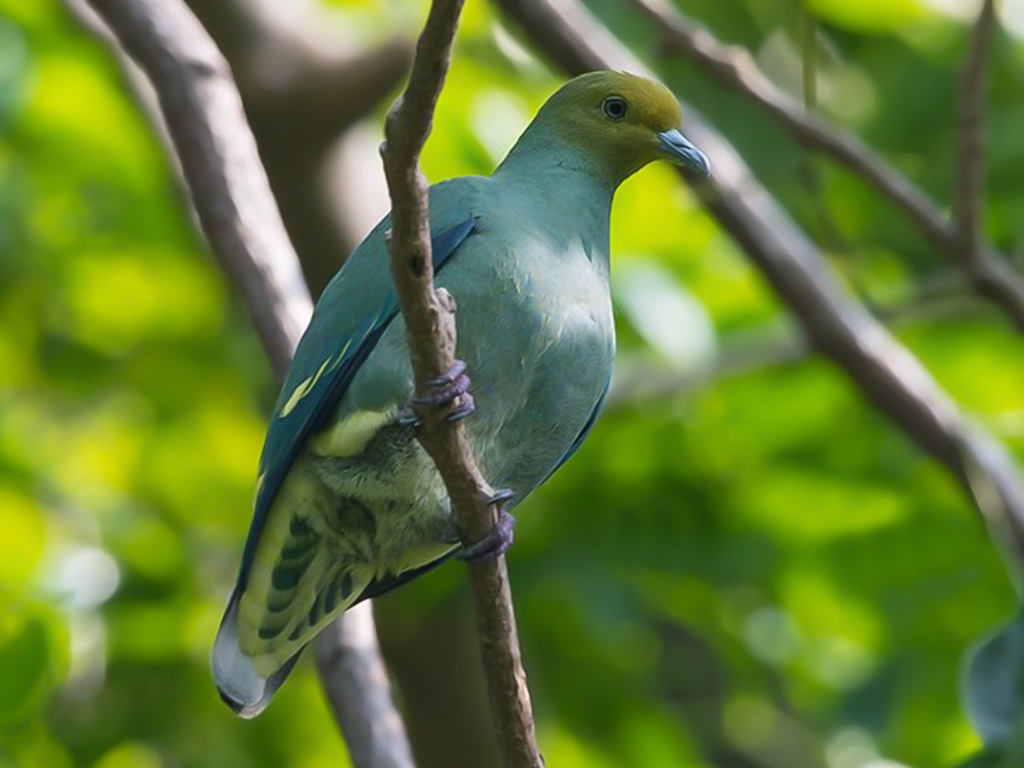
The Tanna fruit dove is a species of bird that resides in Vanuatu. It belongs to the Columbidae family, and can be found living in subtropical or tropical moist lowland forests, as well as montane forests and even heavily degraded former forest areas.
This small but beautiful bird has an olive green head with pink on its breast area fading into yellow towards its belly region.
Its wings are mostly orange-brownish with white spots near the tips; it also has red eyes along with a purple-red base bill coloration which contrasts nicely against its bright feathers.
The diet of this species primarily consists of fruits such as figs and other berries from nearby trees or shrubs – hence why they have been given their name.
All in all, these attractive birds make an interesting sight for visitors who venture out to see them in their natural habitat around Vanuatu’s lush rainforests.
Scientific classification:
| Kingdom | Animalia |
| Phylum | Chordata |
| Class | Aves |
| Order | Columbiformes |
| Family | Columbidae |
| Genus | Ptilinopus |
| Species | P. tannensis |
11. Vanuatu Petrel

The Vanuatu Petrel, or Falla’s petrel, is a species of seabird found in the Pacific Ocean. It was first described scientifically in 2001 based on specimens taken off Merelava Island in Vanuatu and one bird found ashore in Australia.
This elusive creature wasn’t confirmed to breed until 2009 when its nesting grounds were discovered on Vanua Lava island.
Little else is known about the bird as it spends much of its time flying over remote parts of ocean; however observations suggest that they feed mainly on fish and squid near the surface during night-time hours.
Its population size isn’t well understood but given their relative rarity across their range, conservation measures are needed to ensure this mysterious species survives for generations to come.
Scientific classification:
| Kingdom | Animalia |
| Phylum | Chordata |
| Class | Aves |
| Order | Procellariiformes |
| Family | Procellariidae |
| Genus | Pterodroma |
| Species | P. occulta |
12. Streaked Fantail
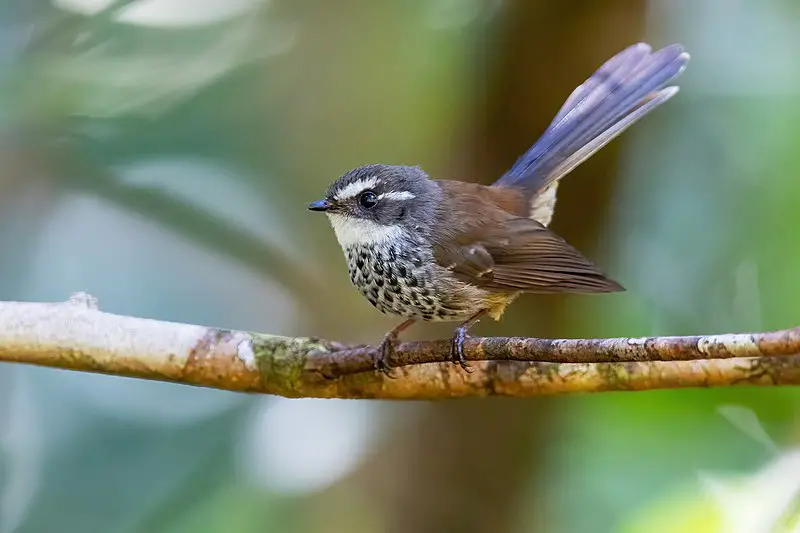
The Streaked Fantail is a species of bird belonging to the family Rhipiduridae. Found in Fiji, New Caledonia and Vanuatu, its natural habitat consists of lush subtropical or tropical lowland forests and moist montane forests.
According to IOC there are five recognised subspecies; Rhipidura verreauxi macgillivrayi (New Caledonia), Rhipidura v. melanorhyncha (Vanuatu) ,Rhipidura v mixta (Fiji’s Lau group); Rhipidura v ruficollis(Viti Levu & Kadavu islands) & Rhopdira V spilodera (eastern Fiji).
This small brown-grey coloured fantail has white streaks across its wings which give it a distinctive look when flying amongst other birds in the region.
It also possesses unique rummaging movements whilst hunting for food on the ground with short hops that make it stand out from other similar looking species.’
Scientific classification:
| Kingdom | Animalia |
| Phylum | Chordata |
| Class | Aves |
| Order | Passeriformes |
| Family | Rhipiduridae |
| Genus | Rhipidura |
| Species | R. verreauxi |
13. South Melanesian Cuckooshrike
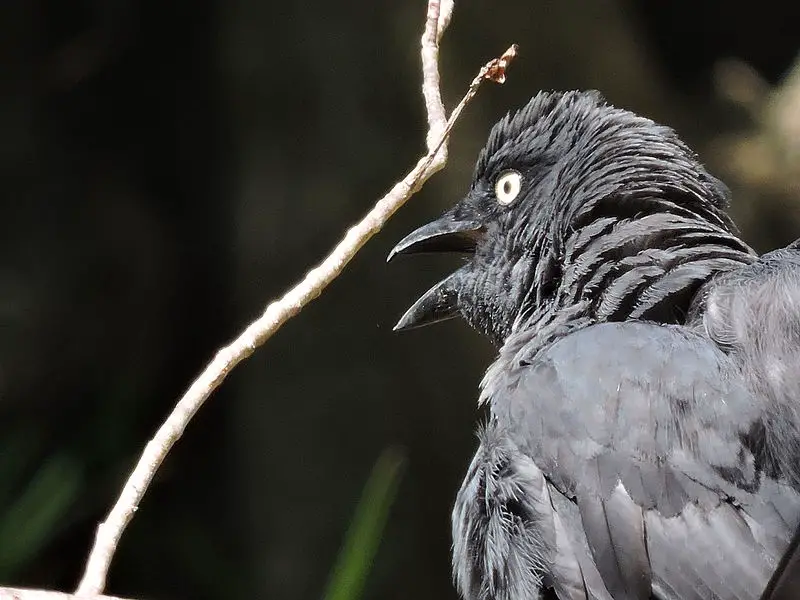
The South Melanesian Cuckooshrike is a large, dark gray bird with a long square tail. It grows to be 32-37 cm in length and can be found in New Caledonia, Bougainville Island, the Solomon Islands and Vanuatu.
The adults of this species have yellow eyes while its young have dark ones. They inhabit sub tropical or tropical moist montane forests as well as subtropical or tropical high altitude grasslands for their home range.
These birds are considered uncommon due to habitat fragmentation caused by human land development activities such as logging and mining operations which make it difficult for them to find food sources they need to survive.
Despite that, these birds still thrive throughout their range thanks in part to conservation efforts being made across the region that seek out ways of protecting them from further harm so future generations will continue on enjoying these impressive creatures.
Scientific classification:
| Kingdom | Animalia |
| Phylum | Chordata |
| Class | Aves |
| Order | Passeriformes |
| Family | Campephagidae |
| Genus | Coracina |
| Species | C. caledonica |
14. Rusty-Winged Starling
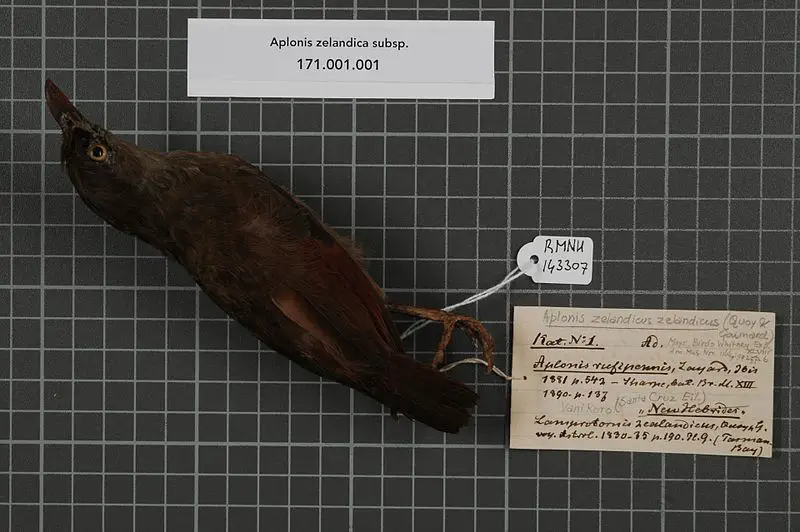
The Rusty-winged Starling is a species of starling belonging to the Sturnidae family. It can be found in subtropical and tropical forests, mostly on Santa Cruz Islands and Vanuatu.
This bird has been threatened by human overpopulation as it leads to habitat destruction which affects its population size drastically.
The Rusty-winged Starling was first described in 1854 for scientific purposes and since then it’s been studied thoroughly due to its uniqueness among other birds present there.
With a wingspan of around 28 cm, this bird usually prefers living near freshwater areas where they find their favourite food sources like insects, fruits or even smaller animals such as lizards.
To protect these beautiful creatures from further extinction immediate action needs to be taken by governments worldwide so that we don’t loose another precious species forever.
Scientific classification:
| Kingdom | Animalia |
| Phylum | Chordata |
| Class | Aves |
| Order | Passeriformes |
| Family | Sturnidae |
| Genus | Aplonis |
| Species | A. zelandica |
15. Grey-Eared Honeyeater
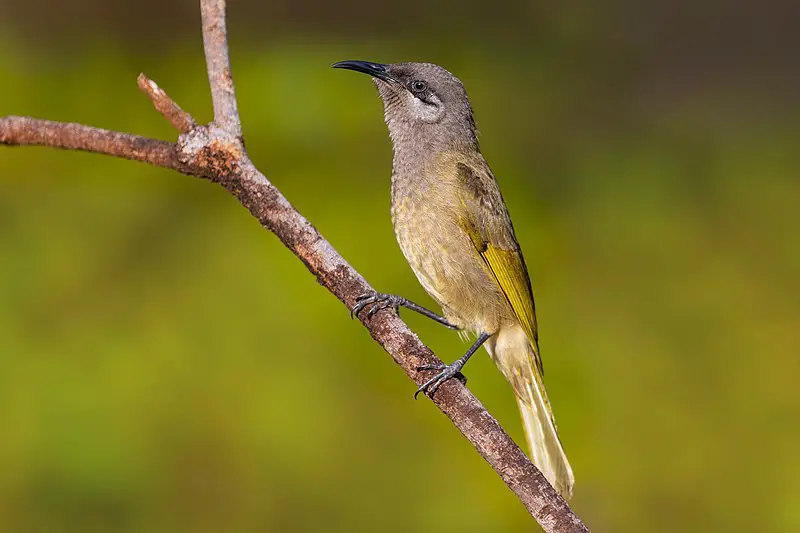
The Grey-eared honeyeater is a passerine bird belonging to the family of Honeyeaters found in Vanuatu and New Caledonia. It measures between 13-17 cm long, with its distinctive grey ear coverts being its main identifying feature.
This species has dark brown upperparts and wings with yellowish underparts, along with white spots on their head and neck feathers.
During breeding season they can often be seen foraging in small flocks around eucalyptus woodlands or other flower rich areas where they feed mainly on nectar from flowering plants as well as insects and fruit.
They are active birds that rarely sit still making them difficult to observe without practice but an experienced birder will be rewarded by excellent views of these hardy little members of the avian world.
Scientific classification:
| Kingdom | Animalia |
| Phylum | Chordata |
| Class | Aves |
| Order | Passeriformes |
| Family | Meliphagidae |
| Genus | Lichmera |
| Species | L. incana |
16. Oceanic Eclectus Parrot
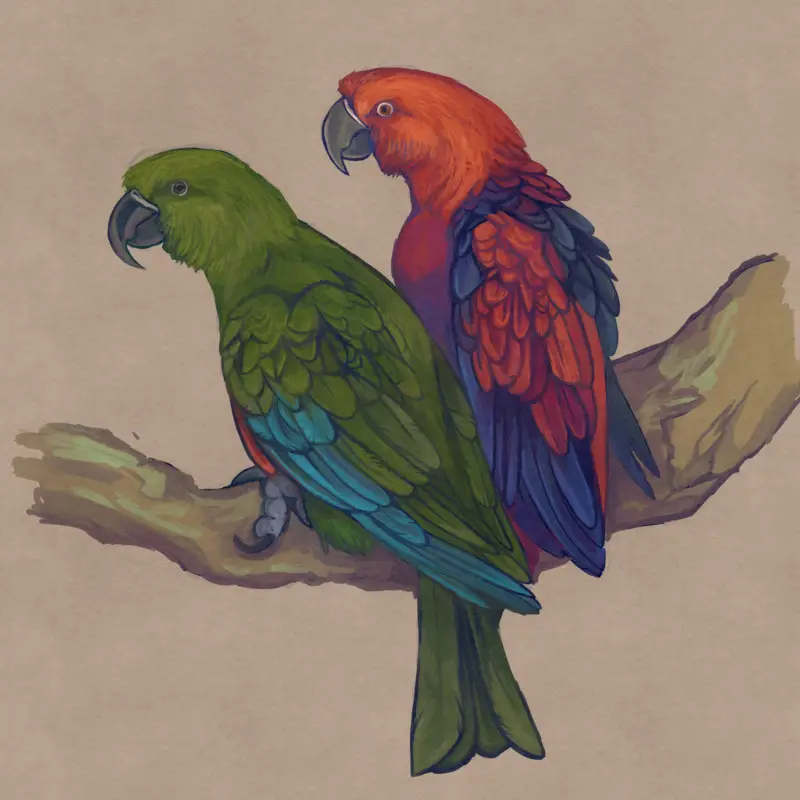
The Oceanic Eclectus Parrot was once a widespread species inhabiting Tonga, Vanuatu and possibly Fiji. It has since gone extinct, with its only living relative being the Eclectus Parrot which is distinguishable by its larger wings.
Fossil evidence of this bird dates back to Late Pleistocene and Holocene deposits on ‘Eua, Lifuka, ‘Uiha and Vanuatu.
This vibrant parrot had bright blue feathers covering most of their body while their head was coloured yellow or orange-red.
Its diet consisted mainly of fruits such as figs, coconuts and guavas found in forests they inhabited near coastal areas making them very adaptable birds that could survive in many different environments; however due to human destruction these habitats were lost leaving the birds without homes leading it into extinction.
Scientific classification:
| Kingdom | Animalia |
| Phylum | Chordata |
| Class | Aves |
| Order | Psittaciformes |
| Family | Psittaculidae |
| Genus | Eclectus |
| Species | †E. infectus |
17. Vanuatu Imperial Pigeon
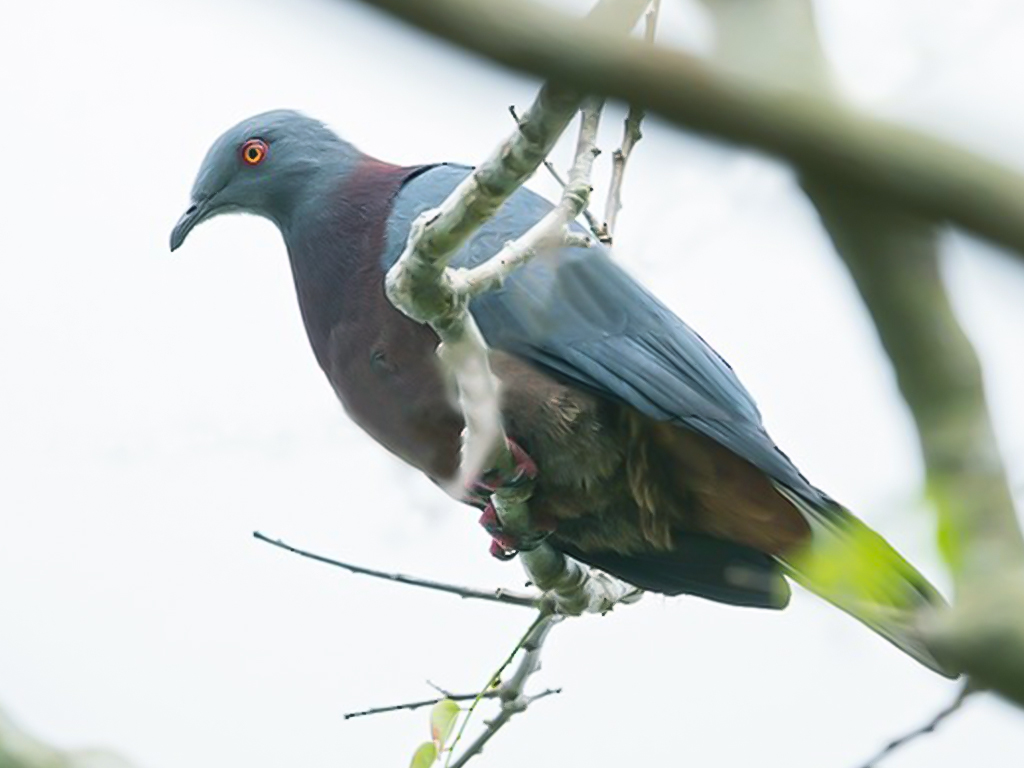
The Vanuatu Imperial Pigeon, also known as Baker’s Imperial Pigeon, is a species of bird found only in the forests of Vanuatu. Endangered due to deforestation and habitat loss, it has been assessed by IUCN (International Union for Conservation of Nature) as vulnerable.
Described from Santo Island in 1928 by Norman Boyd Kinnear as Muscadivora bakeri, this pigeon measures up to 35 centimeters long with grayish-brown plumage on its head and upperparts while its underpart appears brown or chestnut colored.
Its wings are black with white spots when spread out during flight; male pigeons have blue eyes while females have yellowish ones.
This species feeds mainly on fruits like guavas and breadfruit high up in trees which they reach after climbing branches using their feet.
Scientific classification:
| Kingdom | Animalia |
| Phylum | Chordata |
| Class | Aves |
| Order | Columbiformes |
| Family | Columbidae |
| Genus | Ducula |
| Species | D. bakeri |
18. Long-Tailed Triller
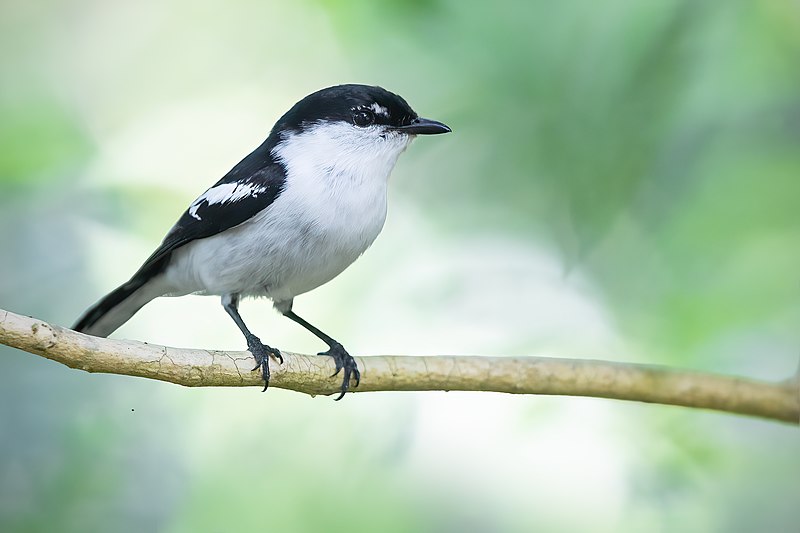
The Long-tailed triller is a species of bird found in New Caledonia, Solomon Islands and Vanuatu.
It belongs to the family Campephagidae and its natural habitats are subtropical or tropical moist lowland forests as well as montane forests.
Sadly, the Norfolk Island subspecies of this bird has become extinct due to human activities such as deforestation.
The long-tailed triller is largely olive green with yellowish eyebrows and wings that have white patches on them when open.
Its tail itself can be up to 20 cm (7 inches) in length which gives it its name.
This beautiful creature loves feeding on insects while perched among foliage or flying through trees searching for food from branches.
Scientific classification:
| Kingdom | Animalia |
| Phylum | Chordata |
| Class | Aves |
| Order | Passeriformes |
| Family | Campephagidae |
| Genus | Lalage |
| Species | L. leucopyga |
19. Melanesian Flycatcher
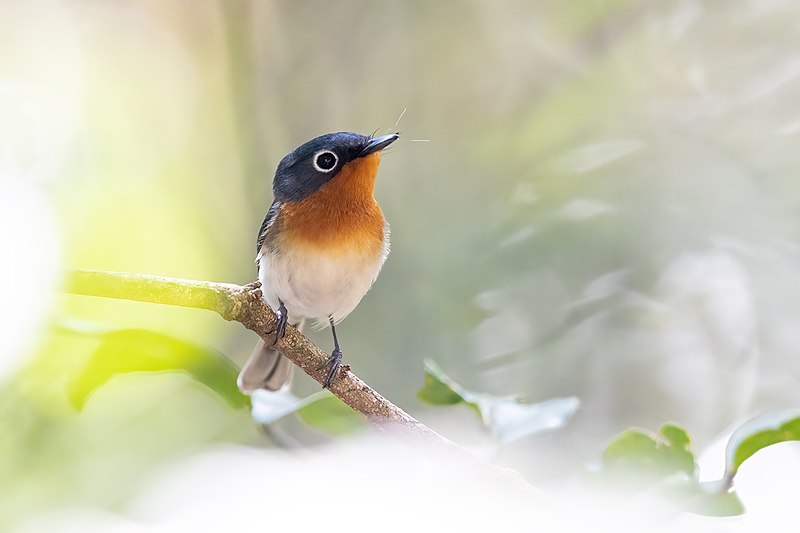
The Melanesian flycatcher is a species of bird belonging to the Monarchidae family and natively found on islands in Melanesia.
It’s closely related to the Vanikoro flycatcher, being known by other names such as broad-billed flycatcher, Caledonian Myiagra Flycatcher or New Caledonian Broadbill.
This small bird has a brown head with white spots near its eyes and an olive green body with yellow tinges along its wings.
Its bill is slightly curved upwards forming a hook shape at the end making it easier for them to catch insects like flies which they usually feed on while perching atop branches during flightless periods.
They are very active birds often seen flying around trees looking for food or nesting materials in order to build their nests which can be made from twigs, grasses among others things depending upon availability.
Scientific classification:
| Kingdom | Animalia |
| Phylum | Chordata |
| Class | Aves |
| Order | Passeriformes |
| Family | Monarchidae |
| Genus | Myiagra |
| Species | M. caledonica |
20. Brown Goshawk
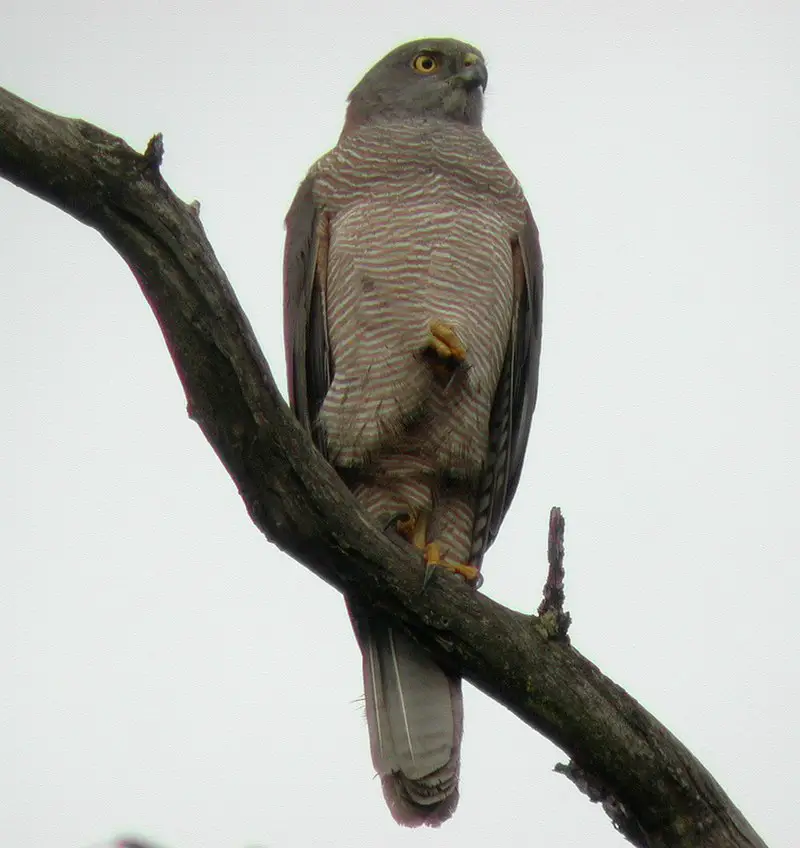
The Brown Goshawk is a medium-sized bird of prey that can be found in Australia and its surrounding islands.
It has grey upperparts with chestnut collar, while the underparts are mainly rufous finely barred with white.
This gives it similar colouring to collared sparrowhawk but it is larger as compared to them; body length being between 40-55 cm.
The flight of this majestic raptor is fast and flexible making for an impressive sight when spotted in the sky.
Its diet consists mostly of small birds, mammals such as rodents or bats, large insects like grasshoppers etc., thus playing an important role in maintaining balance within local ecosystems by controlling population numbers these species.
Scientific classification:
| Kingdom | Animalia |
| Phylum | Chordata |
| Class | Aves |
| Order | Accipitriformes |
| Family | Accipitridae |
| Genus | Accipiter |
| Species | A. fasciatus |
Also Featured In: Birds that Charles Darwin Studied, Queensland Birds You Should Know
21. Palm Lorikeet
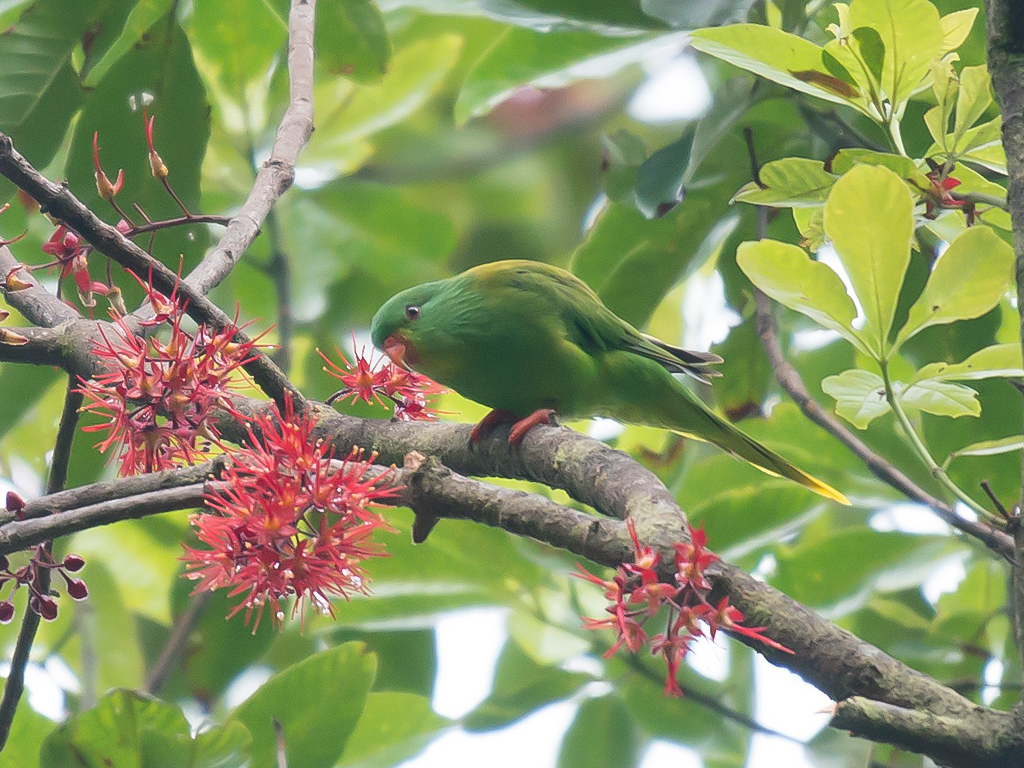
The Palm Lorikeet is a stunning species of parrot native to the Solomon Islands and Vanuatu. It has bright green feathers, with yellow around its face, neck and chest.
Its wings are tipped in blue while its tail feathers have an orange hue at their tips. This colorful bird prefers moist lowland forests or montane forest environments as well as plantations for habitat.
Unfortunately, due to deforestation this lorikeet’s natural habitats are decreasing which makes them increasingly vulnerable to extinction over time if no steps are taken towards conservation efforts now.
The Palm Lorikeet was officially described by German Naturalist Johann Friedrich Gmelin in 1788 who noted it for his incredible beauty and vibrant colors that make him stand out amongst other birds of similar size.
Scientific classification:
| Kingdom | Animalia |
| Phylum | Chordata |
| Class | Aves |
| Order | Psittaciformes |
| Family | Psittaculidae |
| Genus | Vini |
| Species | V. palmarum |
22. Melanesian Whistler
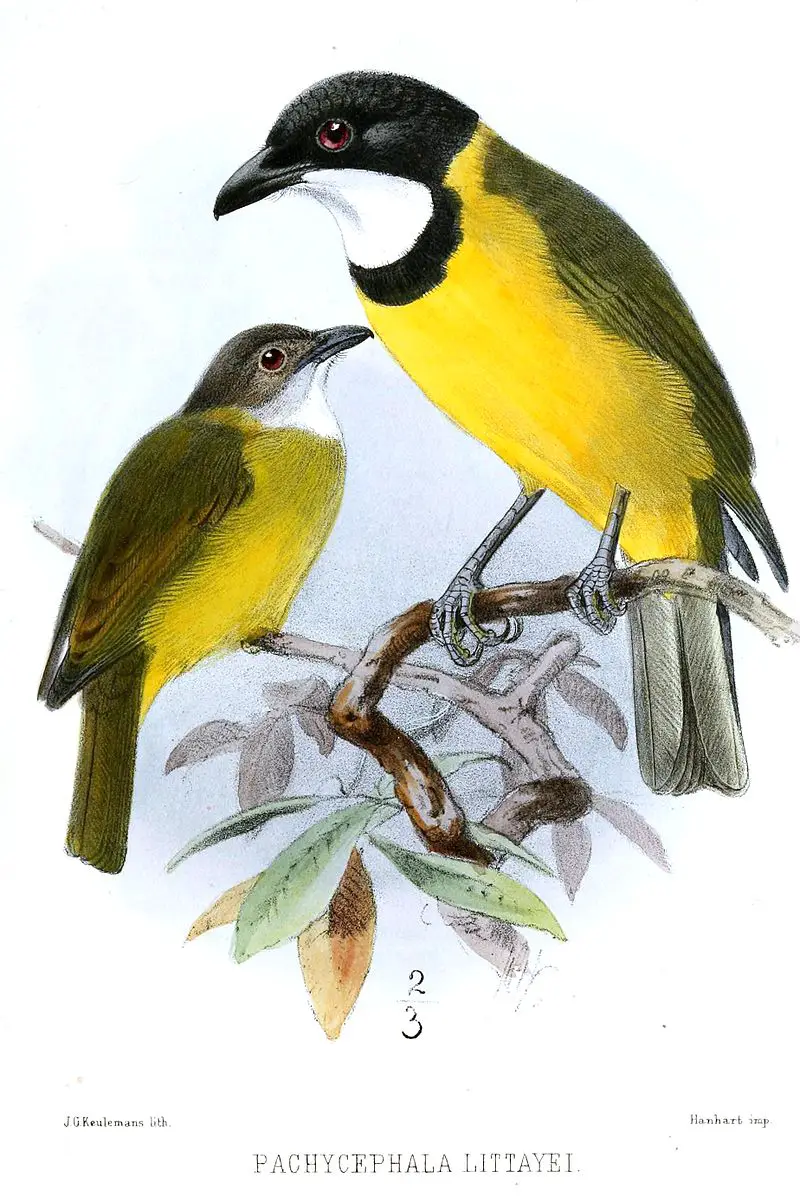
The Melanesian whistler is a species of passerine bird belonging to the family Pachycephalidae. It has its natural habitat in Loyalty Islands, Vanuatu and Vanikoro islands located in southeastern Solomons.
Previously it was considered as conspecific with New Caledonian Whistler but after 2014 it got classified separately.
This beautiful bird can be identified by its golden-brownish head and olive green colored wings along with white tail feathers tipped black at both ends making it an attractive addition to any aviary or garden.
The melodic sound produced from this lovely creature will make you feel relaxed and contentment within no time.
Scientific classification:
| Kingdom | Animalia |
| Phylum | Chordata |
| Class | Aves |
| Order | Passeriformes |
| Family | Pachycephalidae |
| Genus | Pachycephala |
| Species | P. chlorura |
23. Red-Bellied Fruit Dove
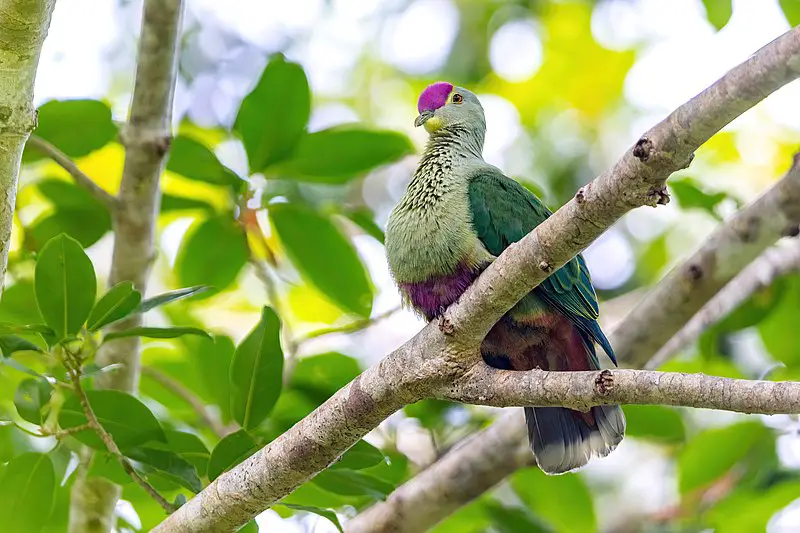
The Red-bellied Fruit Dove is an amazing species of bird found in lowland forests of New Caledonia, the Santa Cruz Islands and Vanuatu. It boasts a beautiful green plumage with purple-red patches on its crown and central belly.
Both genders are very similar to each other, making it difficult to tell them apart at first glance. The dove feeds mainly off fruits located high up in trees or bushes but will also feed on fallen fruit from time to time.
They have been known as gentle creatures who live peacefully among their peers; however they can become aggressive during mating season when food sources are scarce.
All things considered, the Red-bellied Fruit Dove has proven itself to be one of nature’s most colorful birds that deserves our respect for its beauty.
Scientific classification:
| Kingdom | Animalia |
| Phylum | Chordata |
| Class | Aves |
| Order | Columbiformes |
| Family | Columbidae |
| Genus | Ptilinopus |
| Species | P. greyi |
24. Polynesian Triller
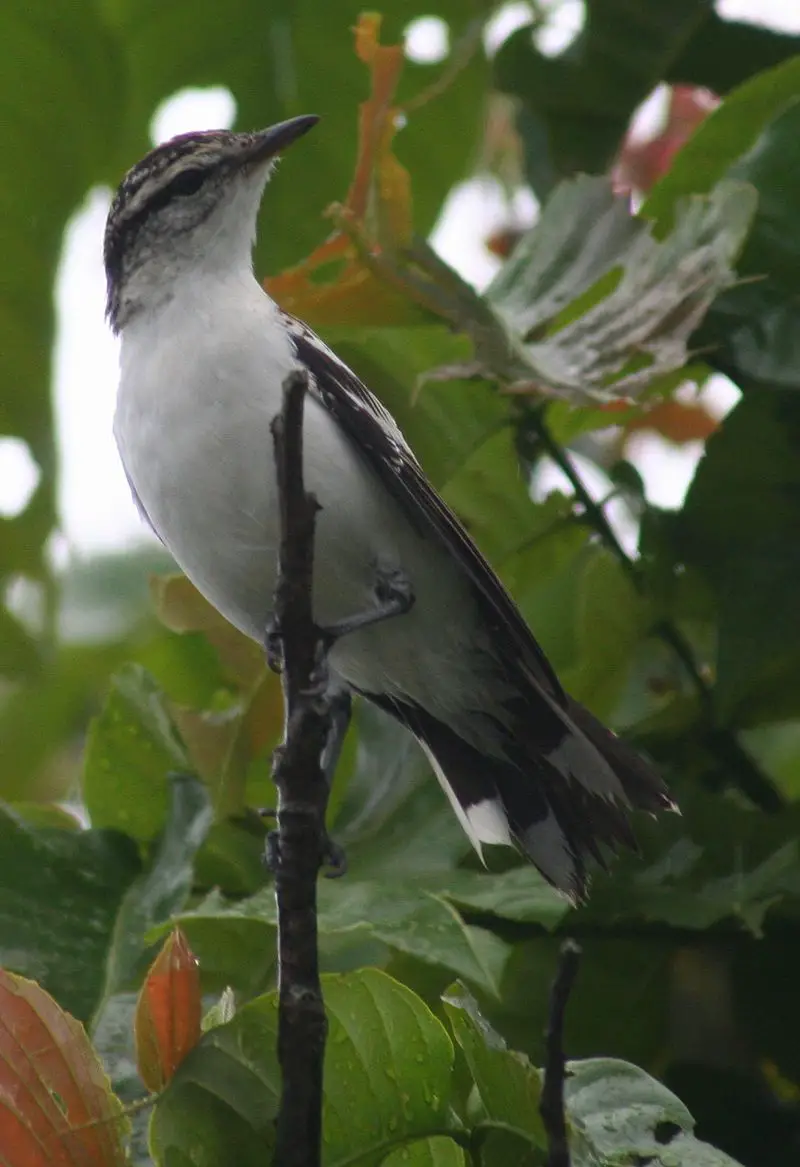
The Polynesian triller is a small passerine bird belonging to the cuckoo-shrike family Campephagidae.
It has numerous subspecies distributed across south-west Pacific islands and can grow up to 15–16 cm in length, with geographically varying plumage ranging from black and white to grey or brown coloration.
This species is known for its loud call which it makes almost constantly throughout the day, making it one of the most conspicuous birds on many tropical islands where it resides.
Its diet consists mainly of insects but will also take fruits when available during times of scarcity.
The Polynesian triller is an important part of island ecosystems as both predator and prey; helping regulate insect populations while providing food for other animals such as snakes and owls.
Scientific classification:
| Kingdom | Animalia |
| Phylum | Chordata |
| Class | Aves |
| Order | Passeriformes |
| Family | Campephagidae |
| Genus | Lalage |
| Species | L. maculosa |
25. Pacific Imperial Pigeon
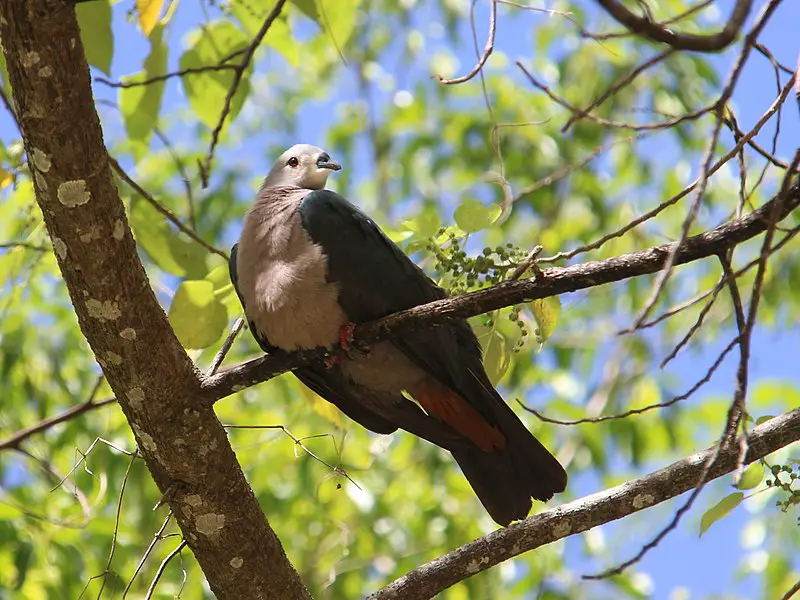
The Pacific imperial pigeon is a beautiful species of bird found in many islands located throughout the South Pacific. It has an iridescent green body, white neck and head with black markings around its eyes and beak.
Its wings are reddish-brown with a large area of blue on each side near the tips. This majestic creature was formally described by Johann Friedrich Gmelin in 1788 and it can grow up to 11 inches long with a wingspan reaching 33 inches wide.
The diet of this amazing avian consists mainly of fruits like figs, mangos, breadfruit, guavas as well as seeds which they search for while flying low over forests or woodlands.
As one can imagine these birds have become very important culturally to many people living within their range due to their beauty and stunning colors.
Scientific classification:
| Kingdom | Animalia |
| Phylum | Chordata |
| Class | Aves |
| Order | Columbiformes |
| Family | Columbidae |
| Genus | Ducula |
| Species | D. pacifica |
26. Tanna Ground Dove
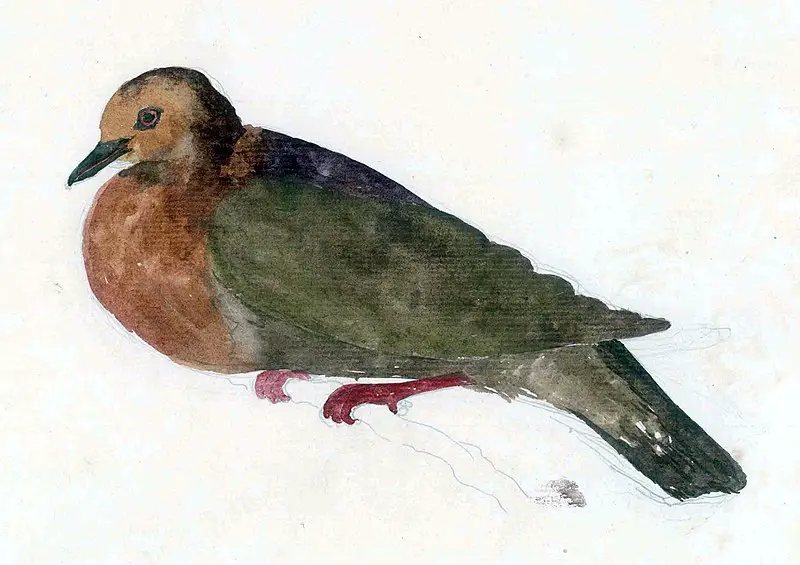
The Tanna ground dove, also known as Forster’s Dove of Tanna, is an extinct species that was endemic to the island of Tanna in Vanuatu. It belonged to the genus Gallicolumba and is believed to be related to the Santa Cruz ground dove.
This beautiful bird had a rusty-brown colouration with dark barring on its wings and tail feathers.
The head was greyish brown while underparts were white or buffy yellow tinged with pink. Its diet consisted mainly of seeds but it could also feed on insects when available.
Unfortunately due to destruction of habitat by humans such as deforestation for timber resources, this species became extinct sometime before 1870s when it last mentioned in literature.
We must take steps towards conservation if we are to prevent other birds from becoming extinct like these majestic creatures did.
Scientific classification:
| Kingdom | Animalia |
| Phylum | Chordata |
| Class | Aves |
| Order | Columbiformes |
| Family | Columbidae |
| Genus | Pampusana |
| Species | †P. ferruginea |
27. White-Rumped Swiftlet
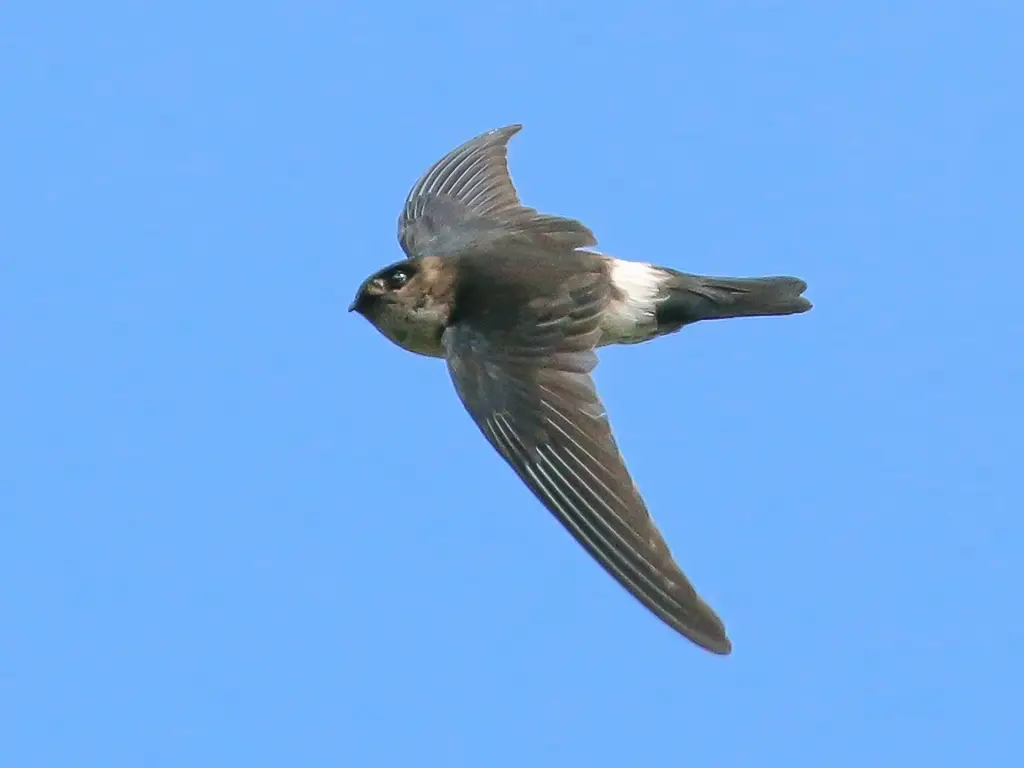
The White-rumped Swiftlet is a species of swift found in the Pacific Islands, including American Samoa, Fiji, New Caledonia and Vanuatu.
It has also been seen in Papua New Guinea and Solomon Islands.
This bird inhabits subtropical or tropical moist lowland forests where it feeds on flying insects such as termites, beetles and flies.
Its main predators are hawks while other threats include deforestation due to logging activities which may reduce its habitat size significantly.
The Australian population was considered separate species (Aerodramus terraereginae) until recently when researchers recognized them as one single species again.
Conservation efforts for this beautiful bird must be done if we want future generations to witness its gracefulness taking flight across our skies.
Scientific classification:
| Kingdom | Animalia |
| Phylum | Chordata |
| Class | Aves |
| Order | Apodiformes |
| Family | Apodidae |
| Genus | Aerodramus |
| Species | A. spodiopygius |
28. Santa Cruz Ground Dove
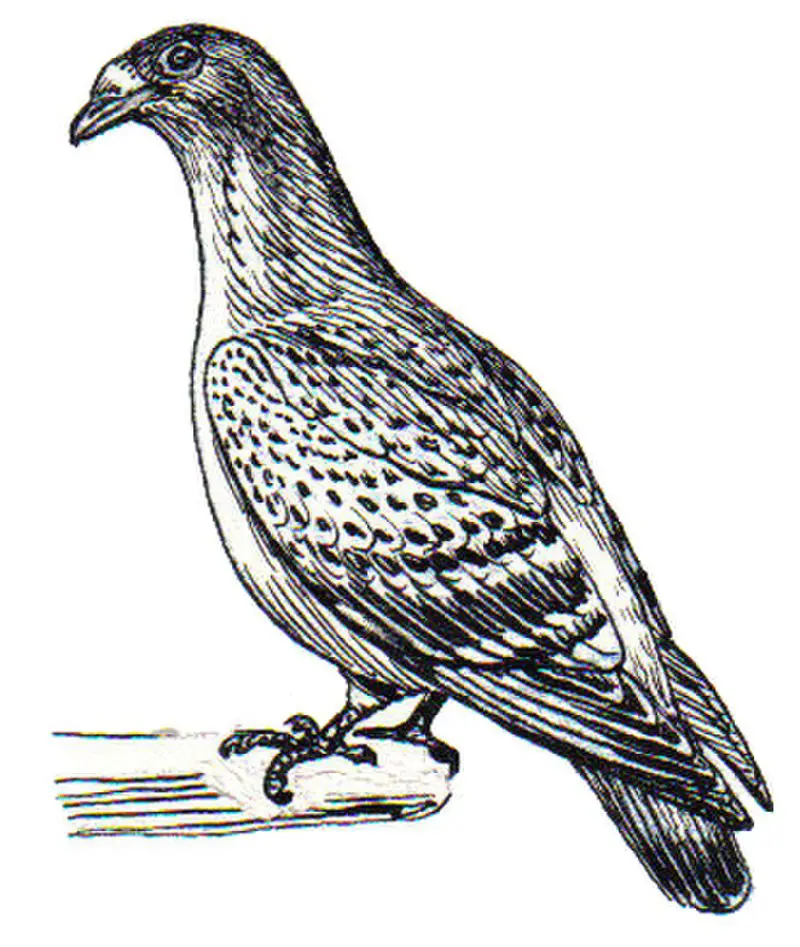
The Santa Cruz ground dove is a species of bird in the family Columbidae, found in the southern Solomon Islands and Vanuatu.
It lives in subtropical or tropical moist lowland forests but its habitat is threatened by destruction as human populations increase.
This medium-sized dove has reddish brown plumage on top with white underneath, pink legs and feet and a yellow bill.
Its former genus was Alopecoenas Sharpe, 1899 until it was recently changed to Pampusana Bonaparte, 1854 due to certain genetic studies.
Although shy at first sight, these birds have been known to be quite inquisitive when approached slowly.
They usually feed on fruits from trees or shrubs but also consume insects for extra protein during breeding season.
Conservation efforts are needed if we want this beautiful bird’s population numbers remain stable over time so that future generations can enjoy them too.
Scientific classification:
| Kingdom | Animalia |
| Phylum | Chordata |
| Class | Aves |
| Order | Columbiformes |
| Family | Columbidae |
| Genus | Pampusana |
| Species | P. sanctaecrucis |
29. White-Bellied Honeyeater
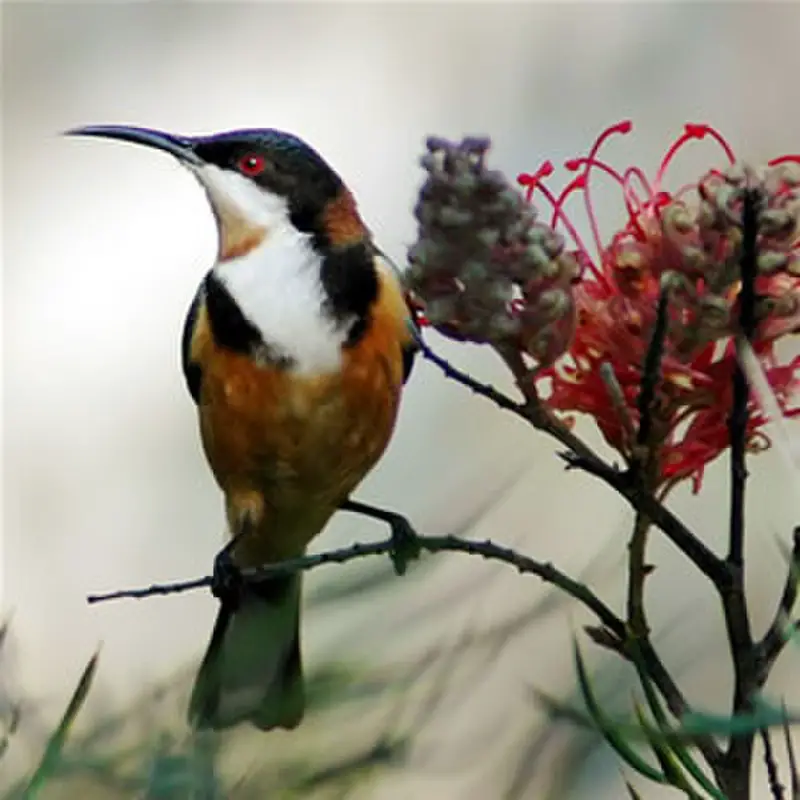
The white-bellied honeyeater is an endemic species of bird found in the Melanesian island nation of Vanuatu.
It belongs to the family Meliphagidae and has a distinctive white belly, which gives it its common name.
This small songbird typically feeds on nectar from flowers and also insects such as beetles and caterpillars which they catch when foraging.
They are generally solitary birds but can form flocks during periods of abundance or while migrating between islands.
The population numbers have declined over recent years due to destruction of natural habitats caused by human activities like logging, mining, etc., making this species vulnerable to extinction unless conservation efforts are taken soon enough.
Scientific classification:
| Kingdom | Animalia |
| Phylum | Chordata |
| Class | Aves |
| Order | Passeriformes |
| Family | Meliphagidae |
| Genus | Glycifohia |
| Species | G. notabilis |
30. Metallic Pigeon
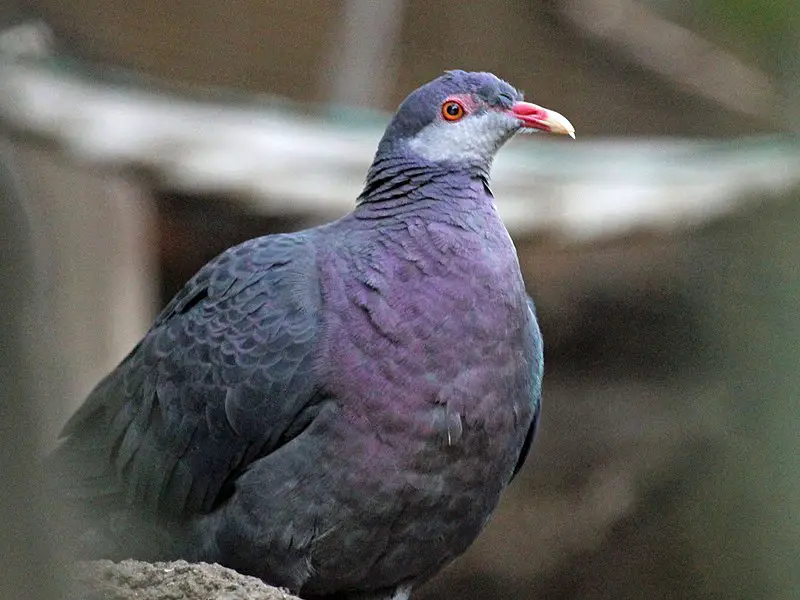
The Metallic Pigeon, or white-throated pigeon, is a medium-sized bird of the family Columbidae. Measuring up to 37 cm in length, it boasts an array of beautiful colors and features.
It has a dazzling iridescent purple and green crown, black wing and uppertail coverts with yellowish red eyes surrounded by red orbital skin around each eye.
Its beak is yellow while its chin and ears are covered with either grey or white feathers.
The underbelly shines brightly in chestnut or glossed purple shades for added beauty when flying about its natural habitat.
Lastly, this spectacular species sports purplish feet which act as perfect complements to their already colorful plumage.
Scientific classification:
| Kingdom | Animalia |
| Phylum | Chordata |
| Class | Aves |
| Order | Columbiformes |
| Family | Columbidae |
| Genus | Columba |
| Species | C. vitiensis |